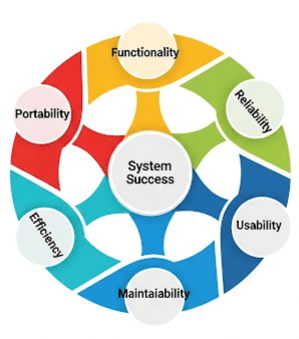- Testing Strategies
- A Strategic Approach To Software Testing
- Test Strategies for Conventional Software
- Black-Box and White-Box Testing
- Validation Testing
- System Testing
- The Art of Debugging
- Product Metrics
- Software Quality
- Metrics for Analysis Model
- Metrics for Design Model
- Metrics for Source Code
- Metrics for Testing
- Metrics for Maintenance
Introduction to Software Quality
Software quality is a fundamental aspect of product metrics in software engineering. It quantifies the degree to which a software product effectively meets its specified requirements and satisfies the explicit or implicit needs of its users. Essentially, it’s a measure of how well a software system fulfills its purpose, performs its functions, and delivers value to its stakeholders. A high-quality software product is not only defect-free but also aligns with user expectations, operates reliably, and can be efficiently maintained and adapted over its lifecycle.
Defining Software Quality
Software quality can be defined as the conformance to explicitly stated functional and performance requirements, explicitly documented development standards, and implicit characteristics that are expected of all professionally developed software. This means that software quality goes beyond mere functionality to encompass aspects like reliability, usability, and maintainability. Consequently, ensuring high software quality is a continuous process throughout the entire software development life cycle.
Key Attributes of Software Quality
Various attributes contribute to the overall quality of software. These characteristics are critical for assessing how well a product performs and serves its users.
Functionality
Functionality refers to the extent to which the software provides functions that meet stated and implied needs when used under specified conditions. It directly addresses what the software does, including features, capabilities, general purpose, and compliance with standards. For instance, if a banking application is designed to allow online transfers, its ability to perform this operation correctly is a measure of its functionality.
Reliability
Reliability is the ability of the software to perform its required functions consistently under specified conditions for a defined period without failure. It indicates the software’s dependability and its resilience to errors. A highly reliable system minimizes downtime and performs consistently, thereby enhancing user trust.
Usability
Usability measures the ease with which users can learn to use the software, operate it effectively, and interpret its outputs. This attribute focuses on user experience, including factors like intuitive design, ease of navigation, and clear feedback mechanisms. High usability means users can achieve their goals with minimal effort and frustration.
Efficiency
Efficiency pertains to the amount of computing resources (e.g., CPU time, memory, disk space, network bandwidth) and time required by the software to perform its functions. An efficient system executes tasks quickly and consumes minimal resources, leading to better performance and lower operational costs. For example, a search engine that provides results rapidly is considered efficient.
Maintainability
Maintainability assesses the ease with which the software can be modified to correct faults, improve performance or other attributes, or adapt to changes in its environment or requirements. This attribute is crucial for the long-term viability of software. It encompasses corrective maintenance (fixing bugs), adaptive maintenance (adapting to new environments), and perfective maintenance (improving functionality or performance). A highly maintainable system reduces the cost and effort of future changes.
Portability
Portability refers to the ease with which the software can be transferred from one hardware or software environment to another. This includes moving the software to different operating systems, databases, or hardware platforms. High portability reduces the cost of migration and allows the software to reach a wider audience or adapt to evolving technological landscapes
